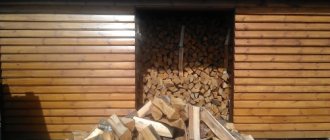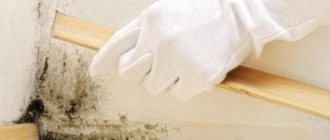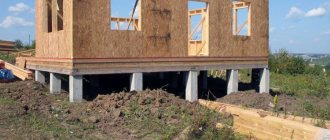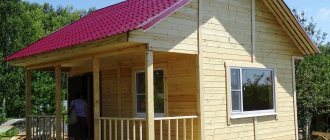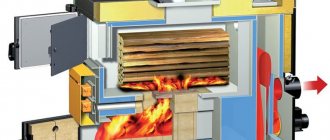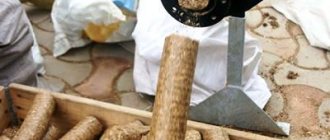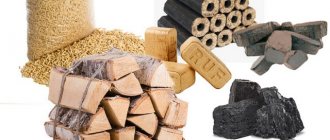Fuel briquettes, also known as Euro-firewood, are today a successful alternative to firewood and coal. Affordability, versatility and other advantages make them an excellent type of solid fuel. They are actively used both for stoves and boilers, and for fireplaces. In this article I want to talk about wood fuel briquettes, and also mention peat analogues.
Fuel briquettes
BUY FUEL BRIQUETTES
How are fuel briquettes produced?
The raw material for this type of fuel is wood processing industry waste. In addition, peat and straw are also used as materials due to their energy value. No glue is used in production; the briquettes contain no foreign binders.
However, the “bricks” hold their shape well and remain hard. At the beginning, the raw material is crushed, which allows it to be effectively dried and then compressed. When sawdust is heated, a natural substance is released - lignin. It is this that allows the wood particles to be bonded together during pressing. It is absolutely safe for humans and the environment. Thanks to lignin, Euro firewood is produced without additional gluing components.
Coal
Coal differs from the other types of fuel presented above in its highest calorific value and combustion duration. When it is burned in so-called long-burning boilers, the greatest autonomy of the heating process is achieved. One loaded coal bunker is enough to operate the boiler for up to 30 days! True, such boilers require special coal, of fine fraction.
The disadvantage of this type of fuel is coal slag, which remains quite a lot when burned. Needs cleaning again. And the smell released during combustion is not for everyone. What does burning coal smell like? Go to any railway station - both in the past and now, passenger trains are heated with coal.
Gortopy does not sell coal, but you can buy it from a private owner. The cost of one ton is from 135 rubles (without delivery).
Advantages of fuel briquettes
If we compare fuel briquettes with the firewood we are used to, we cannot help but note the following advantages of the former:
- High combustion temperature. Firewood burns on average 2 times weaker than fuel briquettes. This is due to their high humidity (about 15-20% subject to storage conditions) and low density. Therefore, their calorific value is significantly lower: approximately 2500 kcal/kg versus 4500-5000 kcal/kg, which are produced when burning briquettes. The latter undergo not only thorough drying, leaving only 5-8% moisture, but also pressing. The combination of high density and low humidity gives briquettes a higher combustion temperature.
- Uniform and long burning. Surely everyone who has burned ordinary wood has noticed the following drawback: a decrease in heat transfer during combustion. In comparison, fuel briquettes burn 3 times longer, while constantly releasing heat. Thanks to such uniformity and long burning, briquettes are consumed much more economically.
- Safe for the environment and humans. Fuel briquettes are produced from waste, which will be a plus for those who care about the environment. At the same time, when burning, they emit little smoke, almost no smell and do not spark. They leave little soot behind, making cleaning faster and easier.
- Compact. Euro firewood is really easy to store, as it has a standard shape and small size. Unlike coal and firewood, each batch of briquettes is similar in size to the previous one. Despite their considerable weight (from 10 kg per package), these “bricks” are quite compact.
Fuel briquettes are compact
Conditions and course of the experiment
The object of inspection is a one-story private house with an area of 150 m² with an individual heating system from a solid fuel boiler. The walls are 300 mm thick and made of white sand-lime brick, with an air gap inside. There is no insulation of external fences; the windows are standard metal-plastic.
The remaining experimental conditions look like this:
- The heating system is closed, two-pipe. It is divided into 2 branches - radiators and heated floors. The initial water temperature is 43 °C.
- The average daily ambient temperature is 4–5 °C. The building is cold, warming up for the first time during the heating season.
- The heat source is a long-burning solid fuel steel boiler DIZ-24 (24 kW), equipped with a turbocharger and an automatic unit for maintaining the set temperature.
- The scheme uses a small capacity buffer tank (150 liters).
Note. Before the experiment, the boiler and coolant were heated to 43 °C by burning small logs.
Task: alternately load 3 types of fuel into the firebox and check the burning duration of each fill at a constant heating mode. The loading size is the same - 10 kg, the automation is set to maintain the water temperature at 50 °C.
Goal: to determine what will burn faster - firewood or briquettes, how significant the difference will be. The secondary goal is to compare the combustion process of three types of fuel:
- dry firewood from barn storage;
- round briquettes from sunflower husks;
- briquetted peat.
For reference. The type of wood used is small elm (otherwise known as birch bark), the stacking density of freshly cut logs with a moisture content of 50% is 600 kg/m³.
We deliberately did not burn “wood” briquettes made from sawdust. The reasons are obvious: the products are noticeably more expensive than peat and agricultural briquettes, and their combustion properties have been repeatedly tested. If you are interested in this type of solid fuel, we recommend watching the video:
The approximate density of pressed husks is 1800 kg/m³, peat briquettes are 2200 kg/m³. These data are for reference and do not play a big role in the experiment, since the fuel was supplied in the same amount - 10 kg. Let's start with burning wood.
The result of burning wood
During the inspection, the logs were cut into 4 logs and loaded into the firebox, where several hot coals remained. The controller started the fan and the firewood ignited within 1 minute. A total of 10 kg of wood was enough for 1.5 hours of boiler operation, after which the coolant temperature began to decrease.
The weight of each portion of fuel is 10 kg (with a bucket - 10.5 kg)
Points worth noting:
- dry firewood produces little smoke and burns very evenly;
- the temperature jump after turning off the fan does not exceed 3 degrees (up to 53 °C);
- small ash residue.
The process of burning dry wood is quite predictable. If you fill the entire chamber of a heat generator of this model (112 liters) with such fuel, 1 fill will be enough for at least 8 hours. Wet (freshly cut) firewood decays faster: it gives off less heat and is therefore more exposed to fan blowing.
A typical picture when burning dry wood is a slight smoke
Briquettes from sunflower husks
Since the pressed husk contains a proportion of vegetable oil, combustion differs in some ways:
- Immediately after placing 10 kg of cylindrical “sausages”, a sharp jump in temperature in the firebox is observed.
- While the oil vapors are burning, the pipe is actively smoking. At this stage, it is not recommended to open the loading door - a powerful flame from a sudden supply of oxygen can burn your face.
- After the boost is automatically turned off, the coolant temperature rises another 6-7 degrees (up to 57 °C), then decreases to normal.
- Until the bulk of the sunflower briquettes burn out, the fan is turned on only for blowing, which is enough to maintain the water temperature.
- When the oil vapors finally burn out, the amount of smoke from the chimney is noticeably reduced.
- The ash residue is insignificant.
At the initial stage (on the left) there is a lot of smoke, then it is practically invisible (on the right)
For reference. The purge mode lasts 10 seconds and turns on at intervals of 5 minutes. The goal is to free the boiler chamber from smoke.
The burning time of a portion of agricultural briquettes was 2 hours 10 minutes, which is 40 minutes longer than firewood. A caveat: you need to learn how to use fuel correctly - at the initial stage, the “sausages” emit a large amount of heat. By the way, in boilers with a mechanical draft regulator (without turbocharging), the effect of primary heating is less pronounced.
This is what the remains of a briquette look like at the after-burning stage, the boiler water temperature is 50 degrees
Combustion of pressed peat
In appearance, peat briquettes resemble coal briquettes, but differ in their square shape. The products also get dirty on your hands, so it is better to load them with gloves. Typical combustion moments look like this:
- under the influence of supercharging, peat ignites well and produces a stable, powerful flame;
- when the set coolant temperature reaches 50 °C, the fan stops, heating “jumps” to 53-54 °C;
- peat briquettes smoke more strongly than dry firewood;
- the amount of remaining ash is approximately 5-10%.
We couldn’t capture the smoke from the peat bricks in the photo because it was dark outside
Note. Peat contains a certain amount of loam, which turns into ash. The size of this share depends on the fuel manufacturer.
The operating time of a solid fuel boiler using peat briquettes is phenomenal - at least 3 hours, which is twice as long as burning the same amount of firewood. An unpleasant nuance is ash content and black dust that sticks to your hands.
Disadvantages of fuel briquettes
Of course, fuel briquettes cannot be perfect for every user. They also have their disadvantages in comparison with the same coal or firewood.
- Lack of moisture resistance. Euro firewood is afraid of water and crumbles when exposed to moisture. When opening the original packaging, you should immediately make sure that the fuel is stored in a dry place where it is not humid.
- They take a long time to flare up. Unlike firewood, briquettes need time to ignite and begin to give off heat. Therefore, it will not be possible to warm up the room quickly with them.
- Not so aesthetically pleasing. We are talking about the cozy crackling of burning wood and the beautiful flame in the fireplace. Fuel briquettes do not burn as beautifully. This is not such a significant minus in comparison with the previous ones, but it is also worth taking into account.
Business planning
It is advisable to start opening a mini-factory for the production of fuel briquettes by drawing up a business plan. It is better to order a full feasibility study of the project from specialists. You can also make an approximate calculation of economic indicators yourself by collecting certain data for your region: prices for equipment and its technical characteristics, the cost of raw materials, the cost of utilities, etc.
The main goal of developing a business plan for the production of fuel briquettes is to draw up a program of economic activity of the enterprise, within the framework of which it is optimal to distribute available resources to achieve the set goals. During its development, it is necessary to find out the degree of reality of achieving the intended results. It must reflect the reasonableness of the costs and profitability of the project. It is useful to learn how to write a proper business plan. Approximate data for calculating the profit and payback period of the project are given in the following table:
| Costs for production of 1 ton of briquettes | ||
| 1. | Raw materials (2 tons) | 400 rub. |
| 2. | Electricity (100 kW/hour) | 550 rub. |
| 3. | Thermal energy (1 MW/hour) + price of dry wood waste | 100 rub. |
| 4. | Salary (2 employees per shift at a rate of 20,000 rubles/month with taxes) | 360 rub. |
| Total: | 1410 rub. | |
| Income | ||
| 1. | Productivity per month for single-shift work (0.5 t/hour × 8 hours × 21 days) | 84 tons |
| 2. | Capacity per year (84 tons × 12 months) | 1008 tons |
| 3. | Minimum selling price | 5000 rub./t |
| 4. | Revenue per month | 420,000 rub. |
| 5. | Revenue per year | RUB 5,040,000 |
| 6. | Profit per month | RUB 301,560 |
| 7. | Profit per year | RUB 3,618,720 |
This table shows only direct costs; packaging, delivery, taxes and other mandatory payments are not taken into account. In addition, productivity largely depends on the quality of equipment and the level of qualifications of personnel. But, as practice shows, such productions pay for themselves in an average of two years of operation.
A little about the cost
At first glance, it may seem that fuel briquettes are unprofitable from a financial point of view in comparison with firewood. The cost of the same weight of these types of fuel varies almost twice, and not in favor of briquettes. However, it is worth considering that one batch may contain firewood of different quality, including high humidity and porosity.
Thanks to the manufacturing technology, each briquette in the package has the same density, and its moisture content is no more than 9%. On average, 1 cubic meter of briquettes is equal to 4-5 cubic meters of the same birch firewood. Therefore, they are more profitable both in terms of characteristics and price.
Fuel briquettes burn for a long time and with high quality
The main principle of choosing fuel for a home with a solid fuel boiler
If you make a request on the Internet, the better and cheaper way to heat a country house with a solid fuel boiler, then dozens of offers and reviews will appear where people talk about their experience. Some just for firewood. Others praise fuel briquettes. And still others prefer coal. The situation is aggravated by the fact that often, suburban residents consider their point of view to be the only correct one and do not want to listen to others. Many copies have been broken in such disputes. How to proceed and come to a common denominator? The solution is to narrow the search for a certain ideal type of fuel for a solid fuel boiler, adhering to the following recommendation.
The more economically profitable the fuel is, the more of it is available on the market (or there is free access to it at a reasonable price) in a particular region of residence of the homeowner.
Somewhere this is firewood. In other places, the processing of wood waste into fuel briquettes is well established. And in coal-mining regions, this type of fuel, especially if it is possible to choose a deposit with high-quality coal, is beyond competition.
There may be another option, when there is a choice of two or three main types of fuel for TT boilers, but a person cannot decide and choose the most rational one. Next, we will talk about real experience of use, as well as the pros and cons of firewood, fuel briquettes and coal.
Coniferous or birch?
At the end, any European firewood has approximately the same density, regardless of the wood species used. Oak briquettes have a higher rate. However, this does not mean that they are necessarily better in quality.
Since conifers are not as dense, it is easier to make fuel briquettes from them. The production cost is lower, which allows you to sell European firewood at a lower cost. Therefore, pine briquettes are often slightly cheaper than their birch and oak counterparts.
It is believed that such European firewood burns better and cleaner due to the resins they contain. Their heat transfer rate is slightly higher, that is, they produce more heat. However, the ash content of this option is higher. The ash does not burn, but remains in the oven. Chimney maintenance when using pine briquettes should be more thorough. This is all due to the above-mentioned resins and ash, which do not burn completely, but remain on the bottom and walls of the furnace.
Unlike their coniferous counterpart, hardwood briquettes contain less ash, and therefore there are fewer by-products from them. They leave no ash behind, no unpleasant odor, and the chimney remains clean longer.
At the same time, it will not be possible to detect any significant difference in the calorific value of coniferous and hardwood briquettes. Therefore, you should rely solely on your preferences and willingness to more carefully monitor the condition of the stove.
Financial plan
Drawing up a financial plan will help determine the amount of necessary investments, further monthly expenses and income, as well as the payback period of the enterprise. In each individual case, these amounts can vary significantly, but it should be borne in mind that the initial investment will always be quite high.
Starting investments
The main costs at the start will be associated with the purchase of equipment. To create a production line you will need:
| Name | Average cost, rubles |
| Crushing apparatus | 100000 |
| Aerodynamic dryer | 800000 |
| Press shock-mechanical screw | 1500000 500000 |
| Feed auger | 80000 |
| Cyclone filter | 35000 |
| Heat generator | 150000 |
| Remote controller | 15000 |
| Band conveyer | 200000 |
| Packing machine | 400000 |
The total cost of equipment with a screw press will be 2,280,000 rubles, and with a mechanical impact press - 3,200,000 rubles. It should be taken into account that the first has a productivity of about 250–300 kg/hour, and the second – 1000–2000 kg/hour, depending on the model.
If we take equipment costs to a minimum (with the purchase of a screw press), then taking into account other costs, the initial investment will be approximately as follows:
| Article | Amount, rub. |
| State registration: payment of duty paperwork | 5000 4000 1000 |
| Arrangement of the premises: Repair Furniture for office and service premises Warehouse equipment | 300000 100000 100000 100000 |
| Purchase of equipment | 22800000 |
| Purchase of raw materials | 10000 |
| Advertising campaign | 45000 |
| Unexpected expenses | 50000 |
In total, starting a business will require 2,420,000 rubles.
Monthly expenses
In the course of business, costs are significantly reduced. First of all, you will need to pay employee salaries, which will be:
| Job title | Salary | Number of staff units | Total monthly payroll |
| Director | 35000 | 1 | 35000 |
| Accountant | 30000 | 0,5 | 15000 |
| Operator | 25000 | 4 | 100000 |
| Equipment adjuster | 25000 | 1 | 25000 |
| Helper worker | 20000 | 4 | 80000 |
| Driver | 20000 | 1 | 20000 |
| Office cleaner | 20000 | 0,5 | 10000 |
The entire monthly wage fund will be 285,000 rubles.
The next major cost will be related to electricity bills. Given the high power of the equipment, on average you will have to pay about 50,000 rubles per month for utilities. In addition, it is necessary to take into account the cost of raw materials and other expenses, which in general will cost the following amounts:
| Articles | Cost, rubles |
| Rent | 70000 |
| Payroll | 285000 |
| Payment of utility services | 50000 |
| Administrative expenses | 10000 |
| Tax payments | 80000 |
| Purchase of raw materials | 10000 |
| Unexpected expenses | 20000 |
The total amount of all monthly expenses will be 525,000 rubles, of which more than half will go to wages. Therefore, as production expands, it is recommended to take care of its maximum automation.
Income
The income of an enterprise producing fuel briquettes using the auger method is calculated according to the following scheme:
- number of working hours for 2 shifts – 16;
- number of working days per month – 30;
- equipment productivity – 300 kg/hour.
It turns out that the workshop will produce about 150 tons of products per month. The average market price of 1 ton of fuel briquettes is 6,000 rubles. Consequently, the monthly revenue will be 900,000, and the net profit will be 375,000 rubles.
As a result, the initial investment will pay off in 6–7 months of full-time work. But since it will be possible to reach the indicated volumes at least 3 months from the start of production activities, we should expect that the payback period will be about 1 year.
The business of producing fuel briquettes is a profitable and very promising direction. The main thing is to find the necessary financial resources to launch it, to properly organize work and sales of finished products. The activity itself is simple and highly profitable, so it can be an excellent startup for the future development of your business.
A little about peat fuel briquettes
Peat washers for heating
Peat is an environmentally friendly and safe material for the production of fuel briquettes. Manufacturers choose low-grade peat, which has virtually no foreign impurities. When such material burns, there are no sparks and no toxic substances are released.
Peat briquettes are able to retain their combustible properties for many years. Like their wood counterpart, it is best to keep them away from moisture. Made in the form of neat bricks or washers, they, like Euro firewood, take up fairly little space and are easy to transport.
Peat briquettes for heating
At first glance, it may seem that peat briquettes for heating are more expensive than birch firewood. However, the calorific value of this material is much higher than that of firewood, so for the same room you will need fewer briquettes than logs.
High flammability can also be considered a disadvantage rather than an advantage. Yes, peat briquettes flare up easily and begin to give off heat faster, but it is more difficult to extinguish such a flame. Therefore, you should immediately think about the safe storage of this option.
Fire wood stoves
Wood-burning stoves provide efficient heating of residential and non-residential premises. They are presented in many models, differing in their technical characteristics and design. They use the most ordinary firewood as fuel - they can be purchased by the truckload. But this fuel cannot be called modern and efficient. And today it has been replaced by fuel briquettes for heating stoves.
To clarify, let's look at the main disadvantages of traditional wood fuel:
Ordinary firewood must first be chopped and then placed in neat woodpiles. This is a very labor-intensive and time-consuming process.
- It is inconvenient to stack firewood in neat stacks - if they are the same size and format, then this is not so bad. But if some logs are thin, while others are thick, and even knotty, then the masonry will be crooked and oblique (although a lot here depends on the “curvature” of the hands);
- Firewood needs to be split - it often comes in the form of round logs that require chopping. Swinging an ax in cold weather is a dubious pleasure (although useful);
- Firewood is often damp - seeking for their own profit, lumberjacks sell the wood in a raw state, without first drying it. Compared to almost dry fuel briquettes for heating stoves, they will not be easy to light;
- Low calorific value - a cubic meter of firewood produces less heat than the same wood briquettes of the same volume ;
- Firewood produces a large amount of ash - the same wood briquettes practically do not clog the stoves;
- Wood burns with clicking and crackling sounds, burns unevenly, clearly inferior to briquettes in this regard.
Firewood is the most common and cheapest solid fuel for heating stoves and boilers. But fuel briquettes are superior to them due to their convenience and high calorific value.
Fuel briquettes Ruf
The German brand Ruf has been offering its fuel briquettes for sale for a long time. High quality raw materials and proven technology allow us not to doubt the manufacturer. Ruf does not use harmful chemicals or bark in its production. Briquettes of this brand burn well, are stored for a long time and have a standard small brick shape. There are both Ruf coniferous and birch briquettes to choose from.
Coniferous briquettes Ruf
Charcoal briquetting
When producing charcoal, about a quarter of it turns out to be substandard - small pieces and dust. To turn this waste into income, you can make briquettes from them. Charcoal briquettes can also be made at home; if necessary, you can make raw materials for this (charcoal yourself). The principle of briquetting charcoal is no different from the formation of the same fuel from coal:
- Substandard coal is crushed.
- Mix with binder. In this case, a regular starch paste will do the job well. The output should be a slightly moist mass. Some of the dust rolls into small lumps.
- The resulting mixture is fed into a press, where briquettes are formed.
This video clearly shows the entire technology of charcoal briquetting, but the guys created a form specifically for the customer (church tablets made from charcoal for incense were ordered). Similarly, you can make a mold of any configuration.
Conclusions. Briquettes from coal crumbs and dust (stone and wood) can be made at home. It is difficult to achieve commercial results (only through automation, and therefore expensive equipment), but for home use it is possible to make a simple installation.
Fuel briquettes Pini kay
Pini kay birch briquettes are commonly called Euro firewood. They are made using a different technology. Unlike the previous manufacturer, which uses a hydraulic press and classic drying, Pini kay uses screw pressing. The wood is crushed and heated to a high temperature and then forced into an extruder. Thanks to firing and high pressure, the output produces fuel briquettes in the form of a polyhedron with a hole in the middle. Very hard and having no more than 0.1% ash content, they flare up quickly and can even be used for a fire or fireplace.
Eurofirewood Pini kay
In conclusion, I would like to say that fuel briquettes are an excellent heating solution! Convenient to transport and safe in composition, they are able to warm up rooms for a long time and efficiently, leaving behind a minimum of waste. They are convenient to store due to their compactness, and in our online store you can choose the ideal option for fuel briquettes made of wood or peat.
And may you always be warm!
Your Kuzmich.
Production
The production process, as we have already said, is quite simple, even though it takes place at home.
To make briquettes for heating stoves with your own hands you need:
- Prepare high-quality raw materials, grind them to the desired consistency, and dry them. In order to improve the quality of combustion, paper can be added to any raw material.
- If necessary, add a binding element (clay, lignin), add water, and load it into the press machine.
- Press the product into a suitable shape at high pressure and preferably high temperature.
- Dry the finished product and, if possible, package it to protect it from external factors. When drying, you can use rags and paper that can draw out any remaining moisture from the briquette.
Having carried out all this work, you will receive excellent fuel, which can be used to easily and quickly heat a bathhouse and heat a house. At the same time, over a long period of time, you will experience the benefits and cost savings from using such eco-drives.
Note that during operation you should try to achieve a briquette moisture content of no more than 10-12% so that they burn well. Industrially produced briquettes have a moisture content of less than 10%.
To make sure of the excellent characteristics of this type of fuel, you can buy yourself some Euro briquettes to try in any store. At the same time, to create a suitable atmosphere, you can sometimes light a fireplace or stove with ordinary wood, because the use of different types of fuel is not mutually exclusive.
